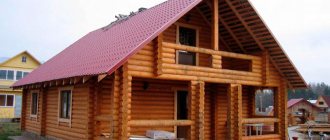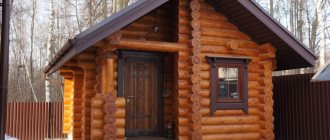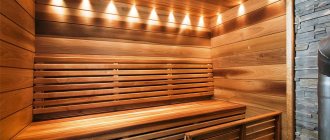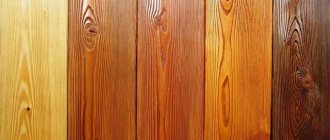Wood in a bathhouse will never lose its position, because, firstly, it is a traditional for bathhouses, and secondly, it is affordable (unless all the forests burn down). Therefore, it is worth systematizing the knowledge about the use of various lumber for baths and saunas, which is presented in the articles published on our website. In addition, lumber is not the only thing that can be made for a bathhouse from different types of wood; windows, doors, and furniture are discussed separately on our website. Follow the links - we always talk to the point, so there is something useful for everyone who has relevant questions.
Lumber for baths and saunas
First, let's find out what exactly can be used in a bathhouse or sauna. If the owner has chosen a wooden building, then it will be made of logs, and it can have either a cylindrical shape (rounded or natural trunk shape) or in the form of a beam (with a square or rectangular cross-section). This is wall material. Of course, in addition to this, you will need boards, beams and beams of various sections, which are involved in the formation of the roof, floor and other elements of the structure.
But even in a building made of brick or other materials, wood can be used. On the roof, on the ceiling and walls, on the floor, as well as for frames and doors, various lumber is used - boards, timber. Rafters, floor beams, sheathing, decking, joists, etc. are made from them. And, of course, clapboard cladding is a separate item.
Boards
A board is lumber whose width is significantly greater than its thickness. In cross section it is an elongated rectangle.
On sale you can find edged and unedged boards. Only the first ones have a section in the form of a rectangle, while for the second ones it is a trapezoid, because the upper plane is narrower than the lower one. Unedged boards are mainly sold with bark residue - wane.
ATTENTION! Wane is considered harmful because it is soft and easily harbors insects. However, they may not start, hence the denials of its harmfulness. We believe that it is worth deleting, but only if the designer does not say otherwise.
We devoted this article to finishing a bathhouse with unedged boards.
In addition to the edge, there are also important points - whoever wants a cheaper is better off taking an unplaned one. Planed boards have a smoother surface that only needs to be sanded. And if you take it unplaned, you will have to plan it yourself.
The same applies to humidity - boards with natural moisture will be cheaper than dried ones, but the buyer will have to provide them with the correct drying conditions (and at the same time be prepared for the fact that some of the boards will eventually be rejected due to warping).
Another factor is the type of wood. Any species of choice is used in the bath, but there are also recommendations - do not use conifers in the steam room, for example.
Resin leaks on coniferous wood
Pine is cheaper and makes good rafters, beams, joists, etc. Linden, aspen, alder and the like, more expensive ones, are perfect for finishing (precisely finishing) a steam room. That is, the sheathing can be made of pine, and the exterior trim and shelves can be made of hardwood.
By the way, if you are choosing boards for shelves, then useful information about their types and sizes can be obtained from this article.
This article will help you choose a floorboard
There is also an option to build a bathhouse entirely from boards . That is, use them as cladding for wall material. This is only possible if the bathhouse is framed, with insulation between the cladding boards. Read about how exactly such a bath is made here.
Wood generally needs treatment, but in a bathhouse it’s worth understanding what kind of treatment is permissible in a particular room, inside and outside in general. This article is devoted to the types of processing of boards in a bathhouse.
Lining
This is also a type of board, but we decided to separate it into a separate category. The fact is that lining is a very popular finishing option, so many questions arise in this regard, the most common of which we answer in our articles.
Of course, everyone wants to find out what the best and ask the price for it. We talk about which lining is worthy of that name in this article.
For those who have already made their choice in favor of inexpensive deciduous wood and are hesitating only between linden and aspen, we have collected the technical characteristics of both woods, compared them and suggest that they bet either on aesthetics or on the best performance. Read about it here.
Before you start laying the lining directly, you need to carry out insulation. Rarely is it not needed. And if in your case there is a need for it, check out the options we described in this material.
Let's move on to installation. How exactly is a bathhouse covered with clapboard? Read about it here. And if you just need to find out what fastening methods , what tools are needed for this, take a look at the article that separately examines fastening methods.
It only remains to mention that the lining is most often a thin board, which is easily moistened, and therefore is at risk of infection by fungi. You can increase its service life using the treatment we talk about in this article.
Log and timber
The thickness/diameter of these lumber varies widely - from 10 cm to an exclusive 40 or more.
The thinnest logs and beams are used either for the construction of buildings that are used only in the warm season, or for internal partitions. In the south of Russia, perhaps, an all-season bathhouse could be built from them.
BUT ! If you insulate a building made of thin logs or beams from the inside, you will get an analogue of a wall made of thicker logs.
The thickness usually recommended for the middle zone is 20 cm ; in more northern areas it is either insulated or thicker logs.
The log itself comes in two types - conical, where the butt part is thicker than the top part, or rounded, that is, it has been machined, bringing the log to the correct shape of a cylinder that is even along the entire length. The latter is more convenient for construction, but when processed, different layers appear on the surface, with different abilities to absorb moisture.
how to choose the best log for a sauna in this article.
The timber also has a different shape - square in cross-section or rectangular, profiled in parts that are joined during the construction of the wall or without a profile (necessary to prevent the formation of cracks, as well as the penetration of moisture). In addition, it can have convex front and back sides, or be straight.
Which of the available timber assortments is best suited for a bathhouse - read here.
If the timber has already been selected, and all that remains is to process and lay it in the wall, we recommend that you read this article before starting work.
BY THE WAY! Logs and beams are processed even before laying the wall begins. This may include treatment with an antiseptic and fire retardants. Treatment (impregnation) does not replace painting, but only precedes it. The material that will be used in the steam room can only be processed on the sides that are not visible in the steam room. The penetration depth is small, there is no cause for concern.
Board cladding for steam room
The most common method of laying lumber cladding involves carrying out work in several stages:
- Initially, an unedged board is stuffed onto the padded vertical slats of the sheathing so that the distance between adjacent edges does not exceed 5-10 mm;
- The formed plane rough cladding from inexpensively purchased unedged aspen boards for the sauna is processed with a belt sander;
- The remaining gaps between the joints of vertically packed boards are closed with a lath or block house.
After treatment with wax, a steam room lined with aspen boards looks no worse than one trimmed with linden or cedar lining.
Advice! If you want to make the decoration of the walls in the steam room truly original, then the board for the steam room is subjected to preliminary finishing and shaped cutting.
Short sections, figures and fragments are laid on a pre-assembled frame made of spruce slats. After assembly, the coniferous wood is hidden under a linden or aspen lining, and no side effects, except for the slight smell of freshly cut wood and heated rosin, are felt in the steam room.
For the production of shaped fragments, trimmings and “short pieces” of full-size aspen or ash boards are used, so the method allows not only to provide an effective design for visiting the bathhouse, but also to significantly save on material.
For comparison, a cube of scraps 0.5-1 m long costs half as much, and pieces up to 0.5 m can be bought five times cheaper than a cube of two-meter boards.
Eternal dispute: oak grove, grove, or forest
From time immemorial, in heated debates on the topic of which wood is the best for a bathhouse, tables, stools, and sometimes even noses have cracked under the blows of fists. Bathhouse fans are not far behind football fans in terms of passion.
The best tree for saunas and steam baths has not yet been named. Each sauna guru defends his own version, and saunas designed by the author can generally boast a dozen or more types of wood in their interior.
Our story is an instruction, but rather a guide sketch, something like sketches on a taiga trail. The photos and videos in this article will help you make your choice, and then build a real Russian wooden bathhouse, dear to your heart, with your own hands. We will start with the general rules; they will be useful to you regardless of what kind of wood you like for building a bathhouse.
Peculiarities
lining for baths is most often used as a universal finishing material that adds practicality and aesthetics to the room. The lining is made in the form of panels with an absolutely smooth surface. It is suitable for finishing all bath surfaces: ceiling, walls, floor, which are perfectly flat and smooth. High rates of sound insulation with “breathable” walls, as well as the absence of condensation, are the main advantages in choosing finishing made from natural material - lining (wooden panels) in a bathhouse. It is not afraid of either high temperatures or constant humidity, but it perfectly covers the layer of insulating material and vapor barrier on wall and ceiling surfaces. Thanks to different types of design, it is easy to install, durable, and the room has an elegant appearance, conducive to enjoying bath procedures and truly relaxing.
Choosing a shower lining
As a rule, all rooms in a bathhouse are usually lined with wood. The shower room is no exception. Panels made from coniferous trees (for example, pine or spruce) will cope well with high humidity and the constant presence of water.
You can improve the properties, protect against rotting and extend the life of the floor covering by applying special water-repellent agents. To do this, the cleaned and sanded surface of the sheathing is coated with protective wax or water-based paint. Sometimes several layers are applied for a better effect.
Waxing creates an invisible barrier to water and air and enhances the beauty of the natural wood grain. The use of paints allows you to paint the surface in any color and shade (read: “How and with what to treat lining in a steam room - practical tips”).
Depending on the purpose, each room in the bathhouse is finished with a certain material. The lining for a bathhouse made of aspen or linden has characteristics that meet all safety requirements.
When calculating the cost of finishing work, it is necessary to take into account the costs of purchasing cladding panels, materials for frame structures and fasteners, as well as antiseptic agents.
Combination of boards from different types of wood
Experienced craftsmen know that the steam room heats up unevenly, the coldest remains the floor, the lower part of the walls under the shelves and the partition between the steam room and the washing compartment.
These are those areas and zones of the steam room in the bathhouse where the heating is approximately 30-40% weaker than on the shelves or directly next to the stove. These areas can be lined with larch or old spruce without much concern. In the hottest places - on the ceiling, on walls up to a level of 40 cm from the floor, surfaces adjacent to the heater must be lined with slats, planks or lining made of linden or aspen. Even cedar wood is used extremely rarely in these areas of the steam room.
In the rest room of the bathhouse, in the corridor and sink, in the dressing room, you can use a block house or even a tongue-and-groove floorboard.
Where are we
- 8
- [email protected]
- Main office:
Moscow, Nakhimovsky prospect, 24, VK Expostroy, hall No. 3, row 11, place 367
Operating mode:
Monday - Saturday from 10 to 20, Sunday from 10 to 19
- Trade pavilion:
Construction fair "MILL" 41 km MKAD, Pavilion NB-33
Operating mode:
Monday - Sunday from 9 to 18
Additional Phone:
8
How to store it correctly
Purchased quality wood should be kept in a ready-to-use condition. On the eve of storing it for long-term storage, it is important to prepare it, in addition to taking care of the woodshed itself. For convenience, it must be located near the bathhouse.
If the tree is damp (recently cut), then it certainly needs to be dried. It is advisable that the wood harvested in the spring lie in a well-ventilated place all summer: only in the fall can it be sawed or split.
To ensure that dried firewood does not lose quality over time, it is recommended to take the following measures:
- To store the workpiece, build a woodshed with a wide roof. It is better to place it in a dry place, away from moisture accumulation (for example, on a small hill).
- When it is not possible to build a protective structure, the firewood should be laid in rows in a well-ventilated area, covered with sheets of slate or other waterproof material on top.
Dried, sawn, chopped firewood should lie in the open air for a while in bulk. Then you need to fold them correctly:
- When storing outdoors, pipes, logs or bricks must be laid under the wood. Otherwise, it will constantly pull moisture from the soil.
- Install vertical trellises on the sides of the woodshed to support the wood stack.
- If the woodpile is planned to consist of several vertical rows, they should be laid with a slight slope.
Interesting! Sometimes the logs are placed in a variety of unusual shapes: for example, “stack”, “house”, “pyramid”, “mushroom”. Then they additionally serve as a unique decoration for the garden plot.
When laying logs in the woodshed, it is necessary to ensure free passage of air between them Source happymodern.ru











